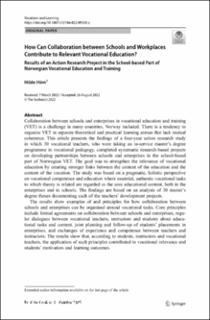How Can Collaboration between Schools and Workplaces Contribute to Relevant Vocational Education?: Results of an Action Research Project in the School-based Part of Norwegian Vocational Education and Training
Peer reviewed, Journal article
Published version
Permanent lenke
https://hdl.handle.net/11250/3071756Utgivelsesdato
2022Metadata
Vis full innførselSamlinger
Sammendrag
Collaboration between schools and enterprises in vocational education and training (VET) is a challenge in many countries, Norway included. There is a tendency to organise VET in separate theoretical and practical learning arenas that lack mutual coherence. This article presents the findings of a four-year action research study in which 30 vocational teachers, who were taking an in-service master’s degree programme in vocational pedagogy, completed systematic research-based projects on developing partnerships between schools and enterprises in the school-based part of Norwegian VET. The goal was to strengthen the relevance of vocational education by creating stronger links between the content of the education and the content of the vocation. The study was based on a pragmatic, holistic perspective on vocational competence and education where essential, authentic vocational tasks to which theory is related are regarded as the core educational content, both in the enterprises and in schools. The findings are based on an analysis of 30 master’s degree theses documenting each of the teachers’ development projects. The results show examples of and principles for how collaboration between schools and enterprises can be organised around vocational tasks. Core principles include formal agreements on collaboration between schools and enterprises, regular dialogues between vocational teachers, instructors and students about educational tasks and content, joint planning and follow-up of students’ placements in enterprises, and exchanges of experience and competence between teachers and instructors. The results show that, according to students, instructors and vocational teachers, the application of such principles contributed to vocational relevance and students’ motivation and learning outcomes.

